sierraclub.org - sierra magazine - july/august 2009 - team of rivals


Team of Rivals
Teens from L.A.'s notorious Crenshaw and Dorsey High Schools come together in Yosemite
By Judith Lewis
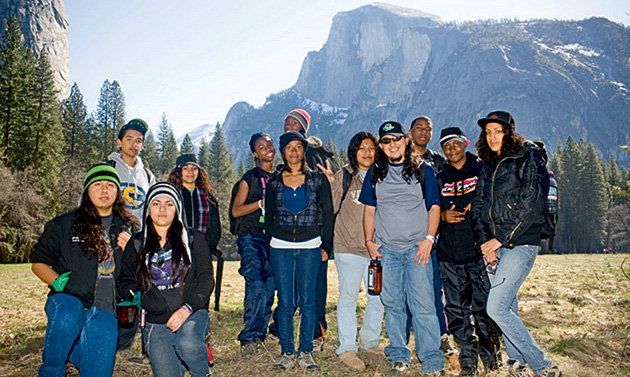
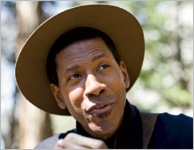 Everyone's Yosemite:
Everyone's Yosemite:
Connecting urban kids to national parks
Speaking across the centuries, an African American "buffalo soldier" from the late 1800s addresses a dozen teenagers from 21st-century Los Angeles. In the character of Elizy Boman, a real sergeant he found in the U.S. Army's muster rolls, Yosemite National Park ranger Shelton Johnson tells of growing up in 19th-century Spartanburg, South Carolina. There were miles of sidewalks through the town, he says, all of them laid by black men forbidden to use them.
Boman didn't like that rule, so he defied it by strolling down the sidewalk one day. When he got home, Johnson continues in character, "My mother and father were standing there looking at me like you never want your mama and daddy to be looking at you. And my father said that maybe it would be a good idea for me to join the army. If I do, maybe there was a chance he wouldn't find me hanging from a tree one day." Boman enlisted, eventually winding up in the newly designated Yosemite National Park.
Johnson has been working on his Boman character since 1999, when he came across a century-old photograph of five uniformed black men on horseback in the Yosemite Valley. Researching their lives, he uncovered the lost legacy of the African American soldiers who enforced laws against poaching and logging in the new park.
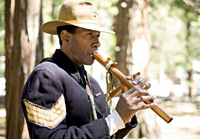
Dressed in a historically accurate blue jacket with three stripes, bag slung over one shoulder, canteen over the other, Johnson tells of the buffalo soldiers, the all-black regiment of the Ninth Cavalry so nicknamed because the men's hair reminded Native Americans of a buffalo's coat. He improvises to draw out the black and Latino teenagers listening to him today.
"What do you think of me walking on the sidewalk like that?" Johnson-as-Boman asks Crenshaw High School junior Avingston Alexander Arnold.

"I think it's good," Arnold says. "I think you did the right thing."
"Why? Why is that?"
"Because when other people see you walking on the sidewalk like that, it means that they can do it too. You were just setting an example."
Johnson has been the first to walk a few sidewalks himself during his 22 years with the National Park Service, 15 as one of the agency's few African American rangers. A Detroit native, he took his first backpacking trip when he was 29 while working as a dishwasher at Yellowstone. "We took a seven-mile hike into the backcountry, and I slept under the stars for the first time in my life," he remembers. On the way back, he and his companion surprised a grizzly and her two cubs. They stood stock-still while the mother bear bluff-charged, then moved off with her cubs.
"To have had that kind of closeness to the wilderness my first time out was extraordinary," Johnson says. "I learned the wilderness has an edge, and that things might not always turn out okay out there. It made me listen, smell, and hear like I never thought possible."
Johnson found that getting hooked on open spaces made him a minority among minorities. "There's a mind-set that black people don't visit national parks, and they sure don't work in national parks," he says. As an interpretative ranger at Yosemite, he wants to connect African American visitors to their own wilderness history, to remind them that they have an ancestral past at the park every bit as legitimate as John Muir's.
"I'm always saddened to see people here from every country on Earth, but not a single black family from Oakland or Hispanic family from [California's] Central Valley," he says. Inner-city kids would fit right in, he believes, because in their own neighborhoods they often need that heightened watchfulness he experienced in Yellowstone. "The fear I felt when I saw that grizzly wasn't so far off from what I felt growing up in Detroit." Being raised there, he says, "prepped me for being in an environment where I wasn't the only apex predator." --Judith Lewis
We were warned about the rain. Weather forecasts predicted it; a mackerel sky backed them up. Rain jackets and waterproof pants sit near the top of backpacks. What hits the trail above Hetch Hetchy Reservoir around 3 P.M. is no refreshing April shower but a stinging rain driven by a belligerent wind to remind us that in Yosemite National Park, winter still rules.
And Rubicelia Garduno is wearing her forbidden sweatpants.
Ruby, as she's better known, is a sophomore at Crenshaw High School in South Los Angeles, a school whose gang associations were featured in the 1991 movie Boyz n the Hood. But robust young Ruby, long wavy onyx hair whipping around her large purple backpack, is as far from that legacy right now as any kid in America. She is wearing baggy navy sweatpants simply because she looks cute in them.
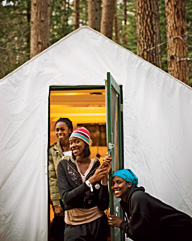 Warm before the storm in their Curry Village tent cabin (from left): Gretanya Gray, Danielle Babb, and Taylor Cumerbatch, from South Los Angeles' Crenshaw High School.
Warm before the storm in their Curry Village tent cabin (from left): Gretanya Gray, Danielle Babb, and Taylor Cumerbatch, from South Los Angeles' Crenshaw High School."Ruby," says a voice behind her, "are you wearing cotton?" Trip leader Cynthia Ramaciotti, 30, is cautiously hurrying her charges up crumbling granite inclines under thousand-foot ribbons of waterfalls, hoping to beat the full brunt of the storm. She takes their every decision personally. Ruby mutters that she is.
"Didn't we talk about that? Didn't we talk about how when cotton gets wet, it stays wet on your body and makes you really cold?"
"
Yeah, we did," Ruby answers breathily. "But it's just because I was wearing my shorts when we started out, and--"
"That makes me really sad, Ruby," Cynthia says. "Remember how we spent that whole afternoon picking through boxes of fleece so you'd be warm and safe out here?" She raises her voice to be heard over the snowmelt-swollen rumble of Wapama Falls, which the kids have renamed in honor of the president.
"I'm sorry," Ruby says, her voice nearly a whisper. "I won't wear them again."
Cynthia directs WildLink, a joint program of Yosemite National Park, the Yosemite Institute (soon to be NatureBridge), and other organizations to bring urban teenagers with little or
no backcountry experience into the outdoors. "There might be drama," Cynthia warned me in advance. "Some kids have issues that don't come up until they're out there with blisters on their feet and five miles left to walk."
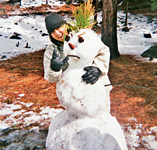 Half the kids on the trip are, like Ruby, members of Crenshaw's Eco Club. For them, the Yosemite expedition marks the high point in a year of hikes and community-service projects. The other half hail from Dorsey High School, Crenshaw's rival in football games and gang affiliation. All are black or Latino, with parents from Mexico, Central America, or the Deep South. None came knowing what it means to be stuck in thin cotton clothes on a wet, cold day at 4,600 feet. Cynthia and Yosemite Institute guide Scott Borden did. "We're responsible for their lives," says Cynthia.
Half the kids on the trip are, like Ruby, members of Crenshaw's Eco Club. For them, the Yosemite expedition marks the high point in a year of hikes and community-service projects. The other half hail from Dorsey High School, Crenshaw's rival in football games and gang affiliation. All are black or Latino, with parents from Mexico, Central America, or the Deep South. None came knowing what it means to be stuck in thin cotton clothes on a wet, cold day at 4,600 feet. Cynthia and Yosemite Institute guide Scott Borden did. "We're responsible for their lives," says Cynthia.
By 4 P.M., still a good mile from camp, dark clouds move in fast, and prickly raindrops turn to painful hail that gathers on the granite steps and collects on hats. By the time we reach Rancheria Falls campsite high above the reservoir, every nonlaminated inch of clothing, not just Ruby's sweatpants, is soaked through to shivering skin. Cynthia and Scott still have to teach a dozen kids how to set up three complicated tents. As I scramble into my own little shelter, the tent-zipper thermometer reads 28 degrees. The steady plot-plot of sleet on my rain fly drowns out everything else.
An hour later I step out into silence. Heavy flakes the size of june bugs flutter down to rest in a canopy of ponderosa pines and cedars. Under a tarp already heavy with snow, Crenshaw senior Leo Morazan and Dorsey junior Emily Cobar are helping Cynthia and Scott cook macaroni and cheese. I set off to find a place to pee and run into Jamise Caesar, a tiny Dorsey sophomore making a rare appearance apart from her equally tiny best friend, Joyce Realegeno. "There's a hollow tree up there," she says with a calm smile. "It's perfect." But for the snow on her eyelashes, it could be any old night in the woods.
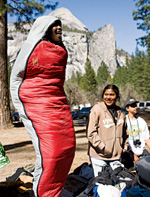 Six-foot-four Danielle Babb's extralong sleeping bag.
Six-foot-four Danielle Babb's extralong sleeping bag.Weather was not supposed to be the story of this trip. When I told people in Los Angeles that I was heading up to Yosemite with six kids from Dorsey and six kids from Crenshaw the second week in April, they warned about brawls and drugs, not snow. The Dorsey Bloods and Crenshaw Crips are notorious; when the schools face off in football games, police cordon off the stadium.
But any rivalry that may have existed before the trip fizzled long before we hit the trail. By the first breakfast in the valley, Leo and Dorsey senior Francisco Jonathan Arce--"Johnny Francisco" to the group--had a friendly handshake that seemed years in the making. Six-foot-four-inch Crenshaw volleyballer Danielle Babb, 16, sat at their table exchanging gossip about everything from Crenshaw's biology-lab dress code to the schools' simultaneous protests against teacher layoffs. The only gauntlet thrown down in that warp-zone breakfast conversation came from Ruby: "Dorsey's golf team sucks," she said.
Danielle slapped her hand on the table. "Basically right now," she announced, "there is no rivalry. So you can forget about that."
These kids are hardly representative of their institutions. Crenshaw dean of students Bill Vanderberg and Dorsey English teacher Robert Jeffers carefully selected them for coveted spots on the annual trip. These are exceptional kids.
But not perfect. Some have been on the verge of dropping out of school, while others are trying to recover from academic failures. At least one has had trouble with the law. Yet the more time I spend with them, the more tragic it seems that the world lumps them in with gangbangers. Where in the popular narrative about inner-city students is there room to talk about Emily's careful study of cactus wren populations in coastal Los Angeles? Or the graceful, quiet cooperation I observe every day on the trail between Dorsey students David "Lucky" Sosa and his girlfriend, Jomara Moreno, who met ten months ago when his band was rehearsing at the same house where she was preparing for her quinceanera?
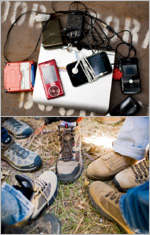 Teen electronics showcase, above; nonurban footwear, below.
Teen electronics showcase, above; nonurban footwear, below.Crenshaw junior Avingston Alexander Arnold admits that until a few months ago he was skipping school and that he was repeatedly arrested for vandalism. "I eventually got sick of everyone I care about complaining about me," he says, "so I got my life together." I think of all the times Avingston reached a hand out to help someone over a tricky creek crossing, how calmly he stood up to the rain and snow. I wonder why his urban world suppresses his steely confidence--and why the wilderness brings it out.
One at a time, the students emerge from their tents into the wet snow for dinner. Some have to be lured. Gretanya Gray, a 16-year-old ballerina from Crenshaw, spent the first 10 years of her life in Belize and is not, she complains, "adapted to cold." She comes out with plastic-bagged feet stuck into her hiking boots. "I want them to stay dry when I put them in my sleeping bag!" she says.
Danielle is beside herself. "I don't want to eat!" she says. "All my clothes are wet."
Scott tries to coax her out of her tent, noting how her body can only keep itself warm during the night by burning calories--carbohydrates in the first few hours, fat through the early morning.
"I don't care about that," Danielle whimpers. "I can't feel my fingers."
"Come and eat, Danielle," Scott orders. "I'm only doing this because I love you."
With some backup encouragement from Leo, Danielle finally ventures from her tent, grumpy and shivering.
"I'm sorry I'm being annoying and lame," Scott apologizes.
"Well," Danielle reassures him, "you're not lame."
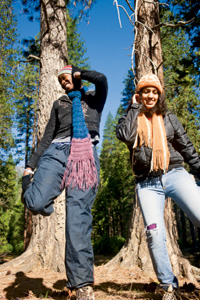 To help learn everyone's name, each student was assigned a dance
step; above, Danielle Babb and Emily Cobar do the "can opener."
To help learn everyone's name, each student was assigned a dance
step; above, Danielle Babb and Emily Cobar do the "can opener."The next morning, hers is one of the first voices I hear, bellowing with joy over the virgin snow now spread throughout our little waterfall valley and up the mountains, flocking the trees like a cheesy Christmas display and still falling all around us. Danielle and Crenshaw freshman Taylor Cumerbatch burst into a medley that includes "Let It Snow" and "Winter Wonderland." The breakfast of oatmeal and hot chocolate thrills them.
"Yosemite," Danielle declares, "makes you corny."
The original plan was to spend the next night higher up the mountain, but Cynthia concludes that breaking camp in the snow would be crazy and elects to stay put. Instead we hike to a spot that overlooks what John Muir once called the "grand landscape garden"--now the vast Hetch Hetchy reservoir serving San Francisco. We sit in a circle and eat lunch off bandannas spread out in the snow. Leo and Lucky recount how, the night before, they ventured down near the river, only to be scared away by the moans of La Llorona, the scorned beauty of Latin American folklore who drowned her children and now travels the earth's waterways searching for them. "If you sleep too close to the river," Lucky warns, "her spirit will claim you."
Black clouds threaten to squeeze out the hint of blue in the sky, but no one seems particularly concerned. Jomara rolls snow into a snow cone and eats it. Leo, Lucky, and Francisco collaborate on a massive snowman with a pine-needle Mohawk, which they then body-slam out of existence.
Ruby sets her soggy sweatpants out to dry in the fleeting sunshine. Cynthia's reproach the day before, she admits, "made the tops of my ears get hot. But she was right--all my other stuff is already dry." Would she come back and do it all again, even in the same weather?
"In a heartbeat," she says. "But for sure I'd leave my sweatpants at home."
Judith Lewis writes about the environment from Venice, California.
ON THE WEB As this story went to press, Crenshaw High School dean of students and Eco Club founder Bill Vanderberg received an Early's Angels award from CBS's The Early Show for introducing hundreds of kids to the outdoors. By way of proof of his motivational talents, he got 250 young people into a South L.A. gym at 4 a.m. to the film the event. You can watch the story of Bill and his students here.
This article was funded by the Sierra Club's Building Bridges to the Outdoors project, whose goal is to give every child in the United States an outdoor experience. Building Bridges to the Outdoors also helped pay for the Yosemite excursion described.
This fall, Sierra Club Books will publish Gloryland, Shelton Johnson's novel based on his buffalo soldier stories. An excerpt will appear in the September/October issue of Sierra.
Photos by Michael Winokur; used with permission.